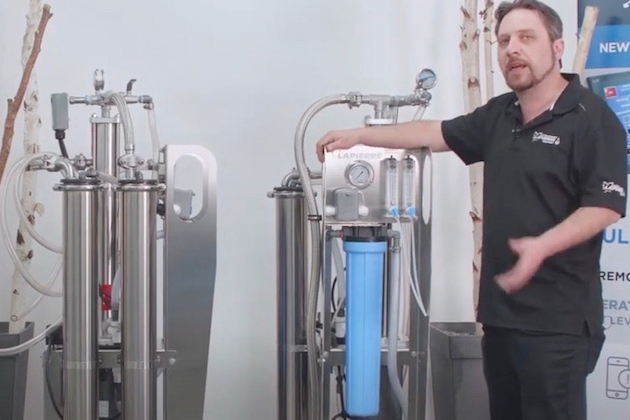Vacuum & RO
Lapierre showcases new RO for small scale producers
Takes out 75 percent of water before boiling
By STAN MADDUX | AUGUST 9, 2021
WYEBRIDGE, Ont.—Sugarmakers on a smaller scale can now remove water from sap with a new reverse osmosis machine that might better fit their budget.
Lapierre Equipment introduced its 1000 Series R.O. during the annual meeting of the Ontario Maple Syrup Producers Association annual meeting on July 22.
Steve Bedard, Regional Sales Manager for Lapierre in Ontario gave a presentation about the machine, which he said is best suited for producers with 1,500 or less taps.
Bedard said the less-costly model was in response to producers who don’t make enough syrup to justify the expense of a larger, higher priced model.
“That’s why we decided to come up with the smaller version,” he said.
Brian Bainborough, past-president of OMSPA, said syrup makers are often hesitant to turn to R.O. machines because of how complicated it looks to operate and maybe not understanding the process of removing water from sap.
He said producers should set aside those fears because of the time and money saved from reduced boiling.
“It is the most intimidating piece of equipment any maple syrup producer buys until they use it and then they can’t be without it,” Bainborough said. “It is the biggest time saver and innovation that has happened in the maple industry in 50-years.”
Lapierre’s new RO has the characteristics producers should look for in terms of performance, durability and being cost efficient to operate, Bedard said.
The 1000 Series RO comes with one or two membranes.
Each membrane is capable of removing up to 75-percent of the water from 100 gallons of sap per hour, he said.
Bedard said the model with one membrane can also be expanded to two membranes for syrup makers wanting to increase production.
Other features include a ¾ horsepower feed pump and an integrated two horse power high pressure and recirculation pump.
Safeguards are also built in to prevent damage to the machine from a pressure drop or rise in temperature while it’s operating.
“You don’t have to babysit anything,” he said.
The R.O. also runs on 240 volts and 16 amps of current.
It might even operate for producers with a limited power supply because of the low amount of energy it takes to run the machine.
“If you’re limited in amps, that could be a good thing,” Bedard said.
Bedard said the new model also meets another characteristic in terms of what producers should look for in R.O.’s, which tend to be complicated and difficult to move.
“You don’t need to play with all kinds of buttons. It’s very simple and easy to use,” he said.
Bedard said the R.O. is also easy to transport.
It also drains easily which helps extend its already long life expectancy, he said.
The wash tank made of plastic does not contain a heater, but a heater can be added if the tank is replaced with one made from stainless steel.
Bedard said the water still heats up but at a slower rate from the friction of the water circulating during a wash.
He also recommended using soap during a wash only when the performance of the machine drops by 15-percent, which happens just occasionally.
Bedard said using soap too often during a wash can hurt the membrane.
“Only use it when it’s time to use it,” he said.
Bedard said the new model is also easy to transport.
He also advised water removed from sap is the best to use for washing an R.O. but tap water can be used as long as it doesn’t contain chlorine.
He said distilled water is also good for cleaning.
“You can also use sap if you’re really in a bind,” Bedard said.
































